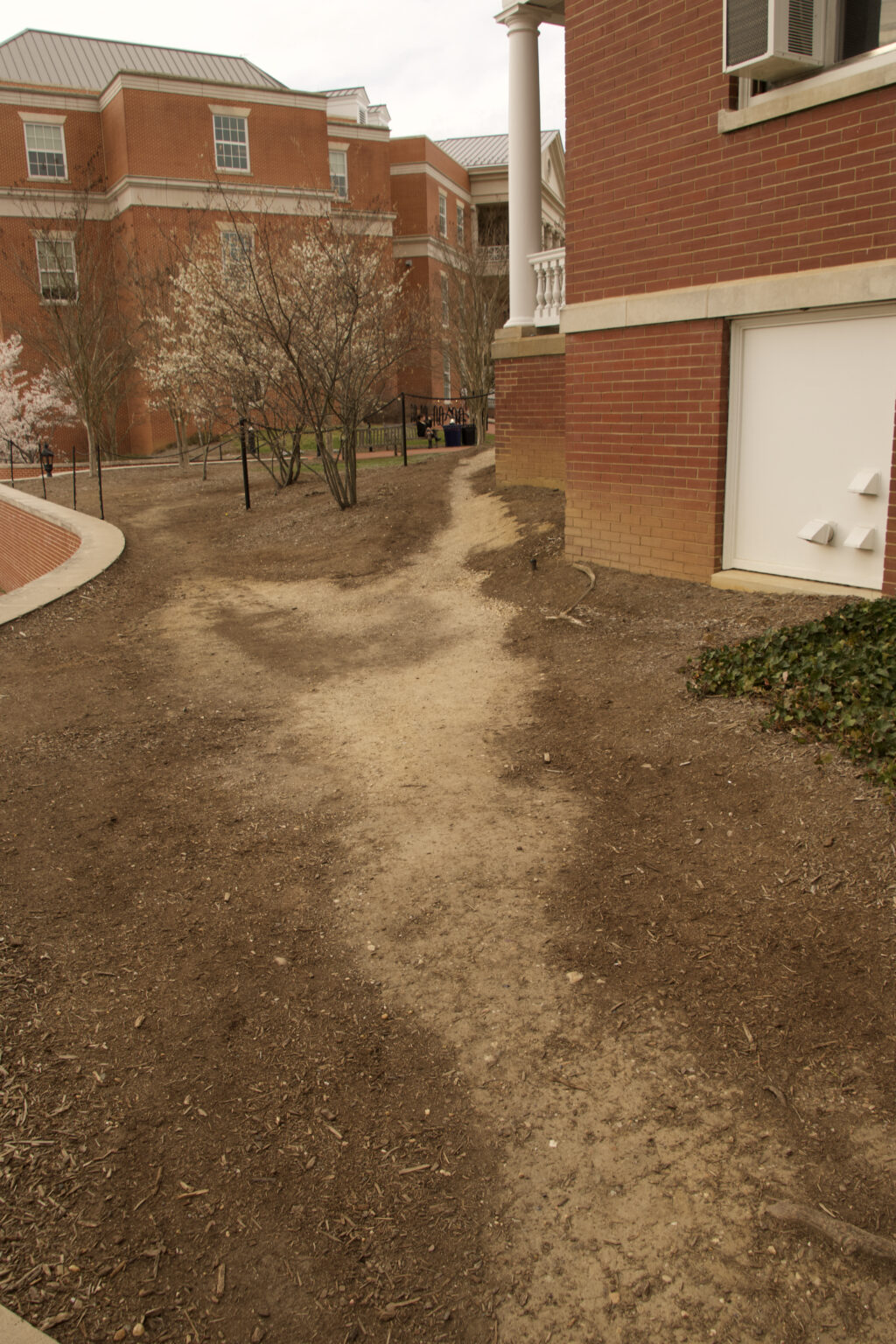Desire paths offer convenient routes around campus that UMW should respect and pave, not reseed and replace
4 min read
Students advocate for the formal construction of a path connecting campus walk to the side of Custis Hall.
by GEOFFREY CARLISLE
Staff Writer
Desire paths are walkways formed by people’s preference to take the shortest route possible. These paths are the result of human erosion and often arise when constructed paths take a longer route. There are many of these paths around UMW’s campus, and the most prominent of the bunch is located between the Cedric Rucker University Center and Custis Hall.
Students and faculty alike take that path. Compared to walking along Campus Walk from the UC to buildings around Jefferson Square, the route along the desire path reduces the walking distance to the UC from .32 miles to .22 miles, a 22% difference.
These paths are the result of students traveling campus and finding more efficient ways of traveling from place to place and are used for a reason. UMW needs to implement and better maintain these paths for the student body.
The desire path near the UC begins in the green space next to Custis Hall and wraps around the back of the building where students merge onto the sidewalk with other students walking to class. There is a staircase that students could use instead, but the route is less intuitive, which has led to the well-trodden desire path.
“I would have to walk down the stairs, over to the sidewalk, and then down the sidewalk, and then back up to where I want to be, but [the desire path] takes me from where I already am to where I want to be,” said Alexa Rousos, a junior marketing major.
Rousos uses the desire path when walking from the parking lot located behind Ball Hall to the UC or vice versa.
However, the path is nearly unusable in bad weather; the ground becomes saturated with rain and snow, creating a natural obstacle that could be prevented if it were paved. This would also help prevent students from balancing on the ledge that drops into the small parking area below as they try to avoid soaking their shoes in the mud.
Ashley Lam, a sophomore biomedical science major, thinks the path is hazardous.
She said, “It also becomes dangerous if people decide to use that pathway, they’ll end up walking along that brick wall, and if something happens, they could fall and hurt themselves.”
And Haylee Saddler, a sophomore psychology major, has experienced this hazard firsthand.
“I have slipped a couple times if the weather is bad and it’s raining. I will like slip when the ground is wet and then it just is not a good scenario,” she said.
Because the path is commonly utilized, students believe that the University should work to make it more accommodating.
“I think that since it’s become its own pathway, making it more accessible by putting like stepping stones or just something,” said Lam about how the University should maintain the path. “That way people aren’t walking through the mud and then making traces of mud everywhere.”
According to Executive Director of Facilities Operations Brian Gorham, “desire paths are discouraged because they lack the formal safety, accessibility, and maintenance typical with planned pathways” and “Facilities Operations do not repair desire paths.”
On March 22, the University roped off and seeded the majority of the desire path between the UC and Custis Hall. The optimal desired route now includes a blind corner, a tree low enough to smack you in the face and a steep ramp. This change left a small section of the dirt path that connects to the existing paved walkway leading to Custis available, which seems to encourage walking along an unpaved dirt path—at least to those of us who want our path back.
Taking Gorham’s words at face value, the UC path is not being repaired, it is being destroyed. Furthermore, trying to reseed the grass is only a temporary solution, for when the ropes come down, people will start taking that path again.
Instead of validating the desire that we have embedded into the campus landscape, the University is taking a passive approach to students’ wishes.
“Desire paths are not currently being considered for paving, nor are they currently endorsed as formal routes on the campus map,” said Gorham.
But Mary Washington has paved similar paths in the past. In 2012—before the construction of the HCC—a short path was paved on the corner of Campus Walk and the path to what was then Alvey Hall. In 2023, the path near the UC, Virginia Hall and Ball Circle was also paved. Clearly these paths deserve some merit, as some of them have been paved on UMW’s campus in the past, so why not this one?
Desire paths have been accommodated by other universities. One of the most famous examples of this is The Oval and Long Walk paths at Ohio State University where the University paved over almost every desire path on the grassy center of their campus. Virginia Tech has also paved over dirt paths on their “Drillfield” in the center of their campus.
The UMW community has expressed their desires, writing their opinion with their feet. While some may have stronger feelings than others, people are taking this path for a reason. It is high time that our desire be heard and met so we can leave our mark on this campus and pave the way for the incoming students who will follow in our footsteps.










